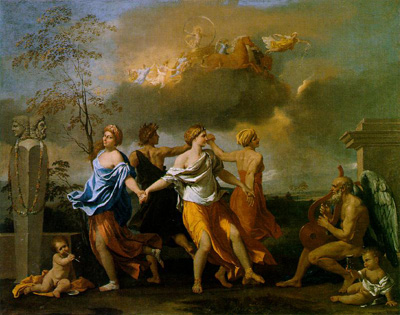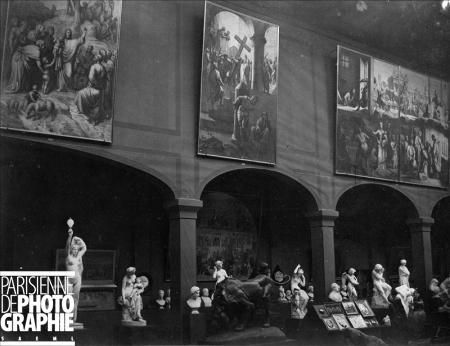Roots of the 19th Century Art Machine
Harrison C. White and Cynthia A. White, Canvases and Careers: Institutional Change in the French Painting World (Chicago: University of Chicago Press, 1993), pp.5-7, 16-18.
THE medieval painters' guilds still ruled in French cities at the beginning of the seventeenth century. Their privileges were jealously guarded, but inroads had already been made
in their once solid legal front and a more complicated framework was developing.
Essential to this new framework was the international diffusion of art and the shifting of its centers. The Valois kings (ruled from 1328 to 1589) had imported great Italian works and artists of their era to create unrivaled monuments to the king's glory. It became the custom for many painters to be trained in Rome, far from the French guild system's control. . . .
Against the background of the regency's antipathy toward antiforeigner political disturbance the Italian-trained "free" artists and some rebels within the guild were able to make their play for independence. In 1648 they obtained lettres-patentes from the royal government giving them the right to work in the guild's territory and to conduct a school of drawing. The Royal Academy, so established, was at first merely independent of the guild, but soon dominated and then replaced it in power and prestige.
ARTIST AS LEARNED MAN: TRIUMPH OF THE ROYAL ACADEMY
Nicolas Poussin, The dance to the music of time (1620) |
In consolidating its monopoly of privilege, the Academy also
emphasized a new conception of the artist: no longer an artisan or a low-caste hawker of wares, he was instead a learned man, a teacher of the high principles of beauty and taste. Under Charles Lebrun as rector, the Academy obtained the monopoly on the teaching of drawing "from life," expanded its membership by forcing all "free" painters and brevetaires into its organization, and laid down the ideological framework -- a rigid hierarchy of subject matter by cultural importance, a definition of "correct" style and a program of training to inculcate it -- that was to persist as the basis of the Academic system.
The concept of an academy was an Italian import as were some of the theories on style. Holding aloft the example of Poussin, the revered Italianate-French master, Lebrun and some of his successors succeeded in imposing certain theories as doctrine. In brief, these were the precepts:
1. Classical and Christian themes are the only proper subject matter.
2. Only the most "perfect" forms (as found in classical sculpture and the painting of Raphael) should be selected from nature to portray such subjects.
3. Only a certain set of "nobly" expressive positions and gestures (again classical or high Renaissance in origin) are appropriate in the representation of the human figure.
4. The human figure is the highest form and expresses perfect "absolute" beauty.
5. Pictorial composition should preserve classical balance, harmony, and unity: there should be no jarring elements either of form or expression.
6. Drawing is the probity of art. . . .
THE Revolution brought the most critical change in the Academy since its inception. The Royal Academy of 150 or so members was suppressed in 1792. This move came at the
instigation of a dissident group from within its ranks, led by its young public hero, Jacques-Louis David. After several Republican substitutes under David's direction, the Academy returned in its new form as the Section de Peinture et Sculpture o£ the Classe des Beaux-Arts in Napoleon's Institut de France. Six of the eight original members, including David, were former members of the Royal Academy.
In 1803 the lnstitut was reorganized and the painting section membership increased to ten. Its powers were well defined by the emperor. Along with the traditional jurisdiction over the Prix de Rome [a prize which allowed a young artists to study in Rome] and the Academy at Rome, this section had the exclusive power over admission and awards in the salons. Moreover, although state prizes, commissions, and teaching appointments to the new Ecole des Beaux-Arts were subject to approval by the government ministry concerned with fine arts, the real power of selection lay with the Section de Peinture.
Palace of Fine Arts at the 1855 International Exhibition in Paris |
GOVERNMENT PATRONAGE AND THE NEW ELITE
The principal concern of the revolutionary and succeeding nineteenth-century governments was legitimation. Following the royal examples of the past, art was accepted as being an essential exposition of the symbols of power. Nineteenth-century France exhibited the most widespread, comprehensive government involvement with art of any state. The culmination was the international exhibitions in 1855 and 1867 at which Louis Napoleon dazzled the sovereigns of Europe with French art.
Patriotically symbolic history painting, which had flourished under Lebrun, was given a new impetus in David's severely classicist painting. As director of revolutionary pageants, the new "dictator of the art world" applied the repertoire of neoclassic symbols to costume, processional accouterments, and decorations. From the political symbolism of the Roman Republic it was an easy step to the glorification of Napoleon as the new caesar. So it went with the various restorations and particularly the Second Empire. The Academy, although decreeing pure "history" painting with classical or biblical themes for the aspiring student, came to assimilate to its tradition grandiloquent works on current patriotic events, particularly contemporary battle scenes. . . .
With its new establishment the Academy had elevated the painter to a higher social position than ever before. Not only did it bestow the status of learned man, an equal of the philosophers and men of letters of the other sections of the Institut; but also the Academy was a relatively independent part of the state bureaucracy, and its members were in a position qualitatively very different from that of even the most esteemed court painter, who was, after all, just a higher type of servant. As an example for all to see of what a painter could attain, it was an undoubted influence upon the status of all artists.

